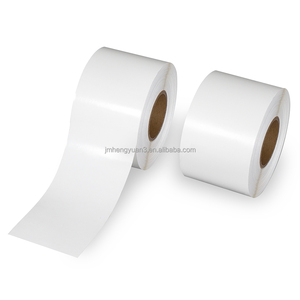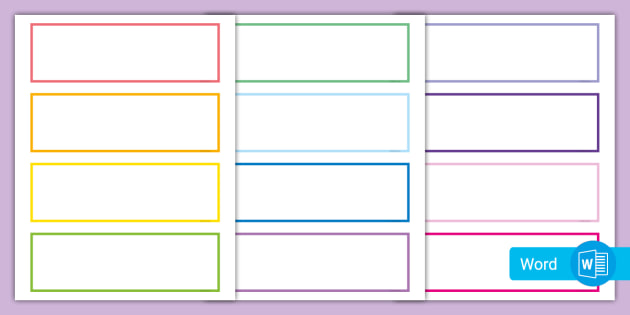Recognizing Exactly How Blank Labels Work to Boost Your Labeling Experience
Comprehending the mechanics of blank labels is crucial for enhancing your labeling techniques across numerous contexts. These flexible devices provide substantial benefits, such as modification and versatility, making them a suitable choice for both specialist settings and personal usage. From inventory administration to home company, the ramifications of their critical application can result in enhanced effectiveness. To totally understand how these labels can change your procedures, one should think about the different kinds offered and the myriad methods they can be personalized to suit particular requirements.

Advantages of Using Blank Labels
Blank labels use a versatile remedy for different classifying requirements, making them invaluable in both individual and professional setups. Their flexibility enables individuals to create personalized labels customized to particular needs, enhancing business performance. Whether used in home workplaces, retail environments, or commercial applications, blank labels facilitate the identification and classification of items, files, and individual things.
One substantial advantage of blank labels is their cost-effectiveness. By allowing users to print only the labels they require, waste is decreased, and supply management becomes much more workable. In addition, blank labels are suitable with numerous printing methods, including inkjet and laser printers, making them available for different individuals.

Moreover, the use of blank labels streamlines the process of upgrading details, as individuals can conveniently print new labels to change outdated ones, making sure that all items and files are precisely classified. In general, blank labels give a useful and effective labeling remedy for diverse applications.
Sorts Of Blank Labels Available
What alternatives are available when it concerns blank labels? Blank labels can be found in a selection of types, each fit for various applications and preferences. The most typical kinds consist of paper labels, which are versatile and affordable, making them suitable for day-to-day use. They are offered in numerous coatings, such as matte and shiny, enabling aesthetic versatility.
One more preferred choice is synthetic labels, commonly made from materials like polyester or vinyl. These labels are recognized for their sturdiness and resistance to water, chemicals, and tearing, making them appropriate for extreme atmospheres. They are commonly used in industrial setups or for labeling products that might be exposed to wetness.
In addition, there are thermal transfer labels, which call for a printer that utilizes warmth to transfer ink onto the label surface area. These labels are preferred for their high-quality print and longevity.
Lastly, specialized useful link labels provide to details demands, such as detachable labels for momentary use or high-temperature labels for extreme conditions. Recognizing these alternatives enables individuals to select the most ideal blank tag for their special labeling demands.
Customization Options for Labels
A wide selection of modification choices is available for labels, permitting customers to tailor them to specific demands and branding demands. Users can pick from different sizes, forms, and products to make certain that the labels successfully fit their intended objective. Typical materials consist of paper, polyester, and vinyl, each supplying various levels of longevity and aesthetic allure.
Shade options play a critical function in customization, making it possible for brands to keep consistency with their company identity. Customers can select from a range of colors or perhaps go with personalized printing to match certain branding elements. Furthermore, labels can be published with distinct layouts, logos, and message, boosting brand acknowledgment and visual effect.
An additional essential facet is the choice resource of adhesive. Tags can be made with long-term, detachable, or repositionable adhesives, depending on the application demands. This adaptability enables efficient labeling remedies across different settings, from retail to industrial settings.

Tips for Effective Labeling
Efficient labeling goes past personalization; it likewise entails calculated considerations that boost performance and communication. To accomplish effective labeling, start by clearly specifying the purpose of each tag.
Next, focus on exposure by selecting proper colors and font styles. High contrast between message and background boosts readability, while larger typefaces help with fast identification. Furthermore, ensure that labels are placed in a regular and rational fashion, making it simpler for customers to locate and analyze info.
Take into consideration the resilience of labels. Select products suited for the details atmosphere where the labels will be made use of, whether it be inside or outdoors. Water resistant or tear-resistant alternatives may be needed relying on the context.
Lastly, on a regular basis testimonial and update your labels to show any type of adjustments in information or usage. This positive technique not just keeps clarity but likewise prevents complication with time. By following these suggestions, you can optimize the performance of your labeling initiatives, guaranteeing they serve their intended purpose efficiently.
Applications of Blank Labels
Blank labels provide many applications throughout different markets, making them a vital device for company and interaction. These flexible labels are frequently utilized in storehouses for stock administration, enabling companies to quickly identify and track products. By using blank labels to storage space containers, shelves, or pallets, firms can enhance their operations and minimize the possibility of errors.
In the healthcare sector, blank labels play a critical duty in classifying medicines and medical supplies, making certain correct identification and usage. Personalized labels can consist of vital info such as dosage, expiry dates, and patient information, improving safety and conformity.
In retail, blank labels help in pricing items, supplying promotions, or classifying shelf locations, which inevitably improves the customer experience. They enable quick updates to rates or item information without the demand for pre-printed labels.
Additionally, blank labels are advantageous for individual use, such as arranging office, crafting, or labeling food containers. Their versatility allows people to create customized solutions that fulfill particular demands. In general, the applications of blank labels are considerable, highlighting their relevance in promoting performance and clearness in Resources numerous settings.
Final Thought
In verdict, blank labels offer a versatile and effective option for numerous labeling needs. Eventually, the assimilation of blank labels right into functional procedures adds to improved efficiency, making them an indispensable source for both individual and specialist usage.